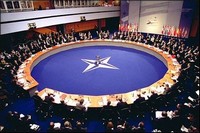NATO’s upcoming Chicago summit in May offers an opportunity for deliberation about the current state of the military alliance, including operations outside its core strategic area. In this context, the recent military intervention in Libya will likely be hailed as a successful and hopefully replicable model (.pdf). Swift and precise action followed by rapid withdrawal represent a welcome change from the alliance’s drawn-out mission in Afghanistan.
In contrast to the Afghan quagmire, the Libyan model, with its prompt termination of military operations and deliberate lack of involvement in the subsequent political transition, looks like a promising alternative. Yet the assumption that Operation Unified Protector was a resounding success may be unwarranted and premature -- calling into question the entire model.
While NATO’s operation in Libya achieved the initial mandate of stopping the violence against the civilian population, the numerous problems now plaguing post-revolutionary Libya cast doubts on the operation’s apparent success.

